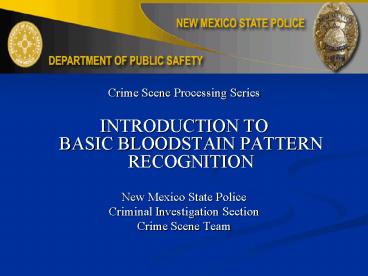Crime Scene Processing Series - PowerPoint PPT Presentation
1 / 53
Title:
Crime Scene Processing Series
Description:
Crime Scene Processing Series INTRODUCTION TO BASIC BLOODSTAIN PATTERN RECOGNITION New Mexico State Police Criminal Investigation Section Crime Scene Team – PowerPoint PPT presentation
Number of Views:394
Avg rating:3.0/5.0
Title: Crime Scene Processing Series
1
- Crime Scene Processing Series
- INTRODUCTION TOBASIC BLOODSTAIN PATTERN
RECOGNITION - New Mexico State Police
- Criminal Investigation Section
- Crime Scene Team
2
BLOODSTAIN CATEGORIES
- There are 4 basic categories of bloodstain
patterns - Transfer stains
- Wipes, Swipes (smearing of bloodstains)
- Pattern Transfers
- Passive stains
- Blood Drops, Flows, Pools
- Projected or impact stains
- Spatter, Cast-off Stains
- Miscellaneous Stains
- Fly spots, expiratory blood, voids
3
TRANSFER STAINS
4
Wipes (object moving through a preexisting stain)
5
Swipes(blood transferred onto a surface by
another moving object)
6
HAIR SWIPE
7
TRANSFER PATTERN
- The pattern created when a wet bloody object
comes in contact with another surface, leaving a
pattern, which may identify the first object.
8
TRANSFER PATTERN
9
BLOODY SHOE PRINT
10
PATTERN TRANSFER
11
PASSIVE AND PROJECTED STAINS
12
THESE STAINS ARE ALSO CATEGORIZED BY VELOCITY
- There are three categories that refer to the
velocity of the wounding agent that comes into
contact with the blood or blood source - Low velocity
- Medium velocity
- High velocity
- It is not the speed that the blood flies through
the air
13
PASSIVESTAINS
14
PASSIVE STAINS
- Gravity is the only force acting on the blood or
the blood source (whatever is bleeding). - These stains would be categorized as LOW VELOCITY
stains.
15
LOW VELOCITY
- Force only from gravitational pull (free falling
or flow) - Most drops in the pattern are 3 mm in diameter or
larger - Remember when looking at the size of a drop,
look at the average size of the all drops in the
pattern. - Patterns may have individual drops that fit the
other categories.
16
DROPS
17
PASSIVE FLOW
18
POOLS (blood in blood)
Serum separation
19
PROJECTED STAINS
- TERMINOLOGY
20
DIRECTION
- The direction a given droplet was traveling at
the time it impacted a surface.
21
ANGLE
- The angle of impact (bloodstain)
22
ORIGIN
- The general area in space where the drop
originates in regard to its flight path
23
ORIGIN
24
IMPACT SITEpoint on the body that receives the
force of a blow (impacts number of blows)
25
MEDIUM VELOCITY SPATTER
- Most medium velocity spatter stains usually range
from 1 mm to 4 mm in diameter. - Spatter stains may travel great distances from
the source - Often seen in beatings, stabbings or cast-off
stains
26
IMPACT SPATTER(MEDIUM VELOCITY)
27
FORWARD SPATTER
- Bloodstains projected in the same direction as
the force or energy being applied. - Seen in both medium velocity and high velocity
events.
28
MEDIUM VELOCITY SPATTER
29
Forward Spatter
Overhead (aerial) view
30
A closer look
31
A BETTER VIEW OF AVERAGE MEDIUM VELOCITY STAIN
SIZE
32
CAST-OFF STAINScreated when blood is flung or
projected from an object in motion, or one that
suddenly stops its motion
33
AN EXAMPLE OF CASTOFF
34
CASTOFF STAINS
35
MORE CASTOFF STAINS
36
HIGH VELOCITY
- Most spatter stains are atomized (1 mm or less)
and can appear as a mist - May travel at most 3 to 4 feet, but can travel
further. - Can be created by firearms, explosions, high
speed machinery. - Expectorate stains can look like high velocity
stains as well.
37
HIGH VELOCITY
38
EXAMPLE OF HIGH VELOCITY AND FORWARD-SPATTER
39
BACK-SPATTER
- Bloodstains which are projected towards the item
creating the force or energy. Most often found in
gunshot situations.
40
BACK-SPATTER
41
BACK-SPATTER ON GUN
42
DRAWBACK EFFECT
- The process of blood entering the barrel of a gun
following the discharge of the weapon. - This effect occurs when the gun barrel is very
close to the body or touching the body.
43
EXAMPLE OF DRAWBACK
44
DRAWBACK
45
MISCELLANEOUS STAINS
46
VOIDS
- A pattern that is created when an object is
between the blood source and the surface where
the blood is striking. - Voids show the specific location of objects at
the scene.
47
VOID
48
FLY SPOTS
- Often confused with high velocity spatter.
- Flies within the scene will feed on blood found
there. This blood is both tracked about and
regurgitated by the flies. - The marks are extremely small but a pattern may
be evident.
49
FLY SPOTS
50
EXPIRATORY BLOOD
- Look for air bubbles (or bubble rings) in the
bloodstains. - Expiratory blood often looks like high velocity
bloodstains. - Often chemical tests for saliva determine if the
bloodstain is expiratory or high velocity.
51
Expiratory Blood
52
QUESTIONS?
53
CREDITS
- Bevel, Tom and Gardener, Ross, Bloodstain Pattern
Analysis, Second Ed., CRC Press (2002) - Lee, Henry, Physical Evidence, Magnani
McCormick Inc. (1997) - Taylor, David, et al., Death and Homicide
Investigation, Specialized Law Enforcement
Training, Inc. (2002)

